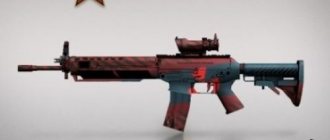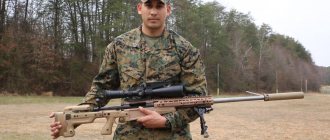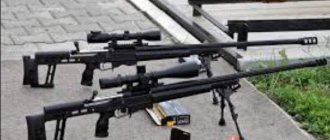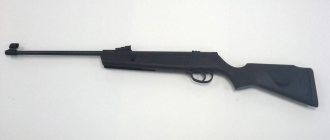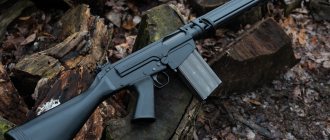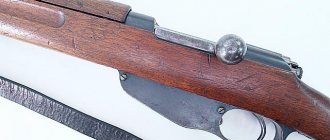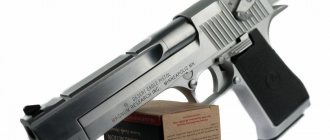Review of bolt-action sniper rifles in the Warface game, tactical and technical characteristics and tips for use
See also:
- Warface: general guide to using weapons
- Warface: review of automatic (semi-automatic) sniper rifles
Today we will continue to take a closer look at the weapons in the MMO shooter Warface . Generally speaking, bolt-action sniper rifles (“bolt-action rifles”) are weapons that are very popular and have many advantages over semi-automatic rifles, while also having one drawback. Most likely, this drawback has less to do with the weapon itself than with its owner: if you miss, then for a short period of time (until the character releases the chamber, replacing the shot cartridge with a whole one) you will be left without the ability to use it.
Each individual rifle in Warface has its own “aura” and requires certain handling. A gamer accustomed to one gun, picking up one that is almost identical in parameters, may experience some discomfort in using it until he gets used to it. And fighters who have spent many hours playing with their favorite rifle effortlessly defeat their enemies.
AX308
A bolt-action rifle created by British gunsmiths on the basis of the AW rifle, inheriting from it strength, reliability, excellent accuracy and ease of maintenance, as well as receiving high ergonomic qualities and low weight. Comes in gold and custom versions from good luck boxes for credits.
TTX
- Recoil: Medium
- Damage: 350
- Range: 80
- Rate of fire: 49 (+1)*
- Aiming Accuracy: 104
- Hip Fire Accuracy: 45
- Magazine capacity: 10 (+2)*
- Ammo: 60 (+12)*
*Differences in performance characteristics from the gold version of the AX308 .
Ranks first for the fastest entry into aim mode of any sniper rifle in the game, thanks to the unique scope it comes with. Has increased damage to enemy limbs, as well as the maximum damage and range of all sniper rifles in the game. One of the disadvantages is the inability to use a muffler. Although real weapons, based on analogues of which the game prototype is made, have such an opportunity. A large magazine will not allow you to frequently reload your weapon during combat. The overwhelming number of players who have at least once held the AX308 in their hands will confirm that it is the best bolt action.
Compatible modules:
Trunk:
- Flash hider for a sniper rifle: reduces muzzle flash and damage reduction at a distance, improves penetration.
Handguard:
- Bipod for sniper rifle: increases accuracy, slightly reduces recoil.
- Shock-absorbing bipod: increases accuracy, reduces barrel drift and recoil.
Aim:
- Standard scope: 5.5x magnification.
- Optical sight: 4.5x magnification.
- Optical sight: 4x magnification.
- Lightweight scope: 5x, fast magnification.
- Schmidt & Bender scope: scope magnification 4.5x.
Ellie
Ellie can access six guns, five of which can be upgraded using parts on workbenches.
Semi-automatic pistol
Ellie's main weapon is given out at the very beginning of the story campaign. Using consumables on workbenches you can upgrade:
- Rate of fire
- Stability
- Return
- Magazine capacity
Semi-automatic (bolt-action) rifle
Like the semi-automatic pistol, the bolt-action rifle is Ellie's default weapon as she progresses through the story. With the help of consumables you can pump up:
- Stability
- Magazine capacity
- 6x scope
- Damage
Revolver
In the “Gatherings” chapter you will come across a red box, inside of which there is a revolver. The following improvements can be applied to it:
- Rate of fire
- Stability
- Recharge speed
- Damage
Pump-action shotgun
In the Downtown chapter, you can find a pump-action shotgun in the Westlake Bank building. You can upgrade the following characteristics:
- Rate of fire
- Stability
- Magazine capacity
Onion
The favorite weapon of all stealth fans can be found at the very end of the Hillcrest chapter. Read the special guide so that you don’t have any difficulties - how to find a bow in The Last of Us Part 2. You can improve:
- Bowstring speed
- Stability
- Rangefinder
Machine gun with silencer
At the very beginning of the “Resort” chapter, a silenced machine gun will automatically appear on Ellie. She will pick it up in a cutscene. This weapon cannot be upgraded.
McMillan CS5
In service with US Special Forces, the Marksman silent rifle with a quick-detachable silencer. It is named after the founder of the McMillan , Gale McMillan, and the abbreviation “CS” (Concealable Subsonic) literally translates as “hidden subsonic”, from which one can conclude about its intended purpose. Available only in a custom version from good luck boxes for credits.
TTX
- Recoil: Strong
- Damage: 350
- Range: 70
- Rate of fire: 54
- Aiming Accuracy: 104
- Hip Fire Accuracy: 45
- Magazine capacity: 10
- Ammo: 60
As mentioned above, the McMillan CS5 is designed to conduct hidden, silent fire. Therefore, the game comes with a unique silencer that will hide the shooter’s position without affecting the damage in any way. It has a high rate of fire and maximum damage compared to many weapons of the same type. Just like the AX308, it has a spacious magazine. Before its introduction into the game, the AX308, and for some still to this day, is considered the best rifle in its class.
Compatible modules:
Trunk:
- Lightweight Silencer: Reduces noise and damage, and hides the shooter's position.
- Silencer for a sniper rifle: reduces noise and damage, hides the shooter's position, increases accuracy.
- Flash hider for a sniper rifle: reduces muzzle flash and damage reduction at a distance, improves penetration.
- McMillan CS5 muffler : reduces noise levels.
Handguard:
- Bipod for sniper rifle: increases accuracy, slightly reduces recoil.
- Shock-absorbing bipod: increases accuracy, reduces barrel drift and recoil.
Aim:
- Standard scope: 5.5x magnification.
- Optical sight: 4.5x magnification.
- Optical sight: 4x magnification.
- Lightweight scope: 5x, fast magnification.
Story
In the middle of the 19th century, designs of shotguns (rifles) loaded from the breech began to appear in large quantities. They used a wide variety of gate designs - tilting, swinging, crane and others.
Dreyse shutter
...and device diagram.
One of the most successful and promising among these early designs of breech-loading weapons, however, was the Dreyse rifle of 1841, which was first equipped with a sliding bolt. In itself, it was still very imperfect, in particular, it used a paper cartridge with a primer located in the bottom of the bullet, which is why to fire a shot it had to be pierced with a long needle, which often broke. However, this was already a real unitary cartridge, and the sliding bolt turned out to be a very rational element, and was subsequently copied many times.
The bolt of the Dreyse rifle was a tube that slides back and forth in the receiver, which forms an extension of the barrel, and contains a locking mechanism inside. It was locked by turning it clockwise; a handle was used as the only combat protrusion, extending beyond the bevel of the massive receiver (very similar to how locking is done in a window latch). Gas breakthrough was partly eliminated by sliding the conical recess of the front end of the bolt onto the conical rear edge of the barrel, ground into the mating inner cone; Firm pressing of the bolt to the surface of the cone was achieved by the fact that the bevel at which the locking was carried out had an inclined surface.
Cone-obturator.
Response cone on the gate.
The Dreyse rifle had numerous advantages. Its rate of fire was very high for that time (up to 10-12 rounds per minute) due to the fact that all operations on unlocking and locking the barrel, opening and closing it, chambering a cartridge into the barrel, as well as placing the firing pin on the combat cock were carried out in one motion by “jerking” the shutter. There was no need to either push the cartridge by hand, pushing it into the barrel, or to cock the hammer separately, as in systems with a hinged, swinging or crane bolt. However, due to its equally numerous shortcomings, this rifle did not receive due attention at the time.
Subsequently, however, a certain number of systems with sliding bolts were created, which to one degree or another imitated Dreyse’s design, including the Green rifle with a “two-bullet” obturation system, Lindren, Terry and others, but almost all of them were unsuccessful and of particular distribution have not received. Green's system was adopted in Serbia for the conversion of Lorenz muzzle-loading rifles, but did not last long in service due to very low reliability - only about 12 thousand units were produced. In Russia, several tens of thousands of obsolete muzzle-loading rifles were converted using the Terry system, improved by gunsmith Norman. All of these were rifles, loaded with non-unitary paper cartridges, with a separate capsule put on the brand tube, very simple in design - their bolts were essentially a simple cylindrical plug, inserted into the barrel from the breech end and locked by turning - but also much less perfect than the Dreyse system.
The bolt of a Chassepot rifle.
Internal structure of the Chasspo system.
The next successful and widely used design of a military rifle with a longitudinally sliding bolt appeared only more than 20 years after Dreyze in France - the Chassepot needle rifle. The Chassepot rifle, adopted by the French Empire in 1866, had all the basic design features that would later be characteristic of single-shot and repeating bolt action rifles. Even externally, its shutter was very similar to modern ones. Like the Dreyse rifle, it had a sliding bolt, locked by turning, the only significant difference was that, firstly, it had a more advanced obturation system with a rubber sealing ring, which was heard when fired under the pressure of powder gases (later a similar system , only with an asbestos gasket, was implemented in French artillery guns - the Debange seal), secondly, the primer in its paper cartridge was located not at the bottom of the bullet, but at the base of the cartridge case, which made it possible to shorten the needle and make the weapon truly reliable. In addition, the powerful 11-mm cartridge gave it very good ballistics for its time.
In 1867, the Russian Empire adopted the Karle needle rifle, somewhat similar to the Dreyse and Chassepot systems, which was used even in the Russian-Turkish War of 1877-78. Around the same time, in 1868, the Carcano needle rifle was introduced in Italy, converted from old 7-line muzzle-loading guns and considered unsuccessful.
In America at the same time, a whole series of very fast-firing magazine rifles with a longitudinally sliding bolt were created for their time, the movement of which was controlled by a movable trigger guard (Henry system). They used low-power rimfire revolver-type cartridges, so their military use was very limited, nevertheless they were extremely popular and played a large role in the development of the so-called “Wild West”.
Bolt operation of the Berdan rifle No. 2.
In 1870, the Russian Empire adopted the American Berdan system rifle No. 2, which had a generally similar design to the French sliding bolt, but already used more advanced central ignition cartridges with a metal sleeve, which made it possible to finally solve the problems with achieving obturation and in general increase the reliability of weapons. When using such a cartridge, it turned out to be very convenient that the spent cartridge case was easily and naturally removed from the chamber using a spring-loaded ejector hook mounted in front of the sliding bolt as it moved backwards. In other systems, where the bolt did not have much longitudinal movement, it was necessary to either pick out the cartridge case from the chamber manually with your fingers, or use additional devices to remove it, which complicated the design of the weapon and reduced its reliability. The chambering of the cartridges was also carried out by the bolt itself as it moved forward, which eliminated the need to insert the cartridge into the chamber of the barrel by hand; it was enough to throw it into the receiver window. Therefore, after the transition to a metal sleeve, the longitudinally sliding bolt turned out to be the most convenient and immediately became widespread.
The longitudinally sliding bolt made it possible to most easily organize the supply of cartridges from the magazine.
In 1871, Germany adopted the Gewehr 1871 rifle, designed by the brothers Peter Paul and Wilhelm Mauser, chambered for a cartridge with a metal sleeve, also with a sliding bolt. The French followed the Germans, adopting the Gra rifle in 1874, which was a modification of the Chassepot needle system chambered for a cartridge with a metal sleeve. Old rifles with bolt-action, bolt-action, and wedge-action rifles lasted until the end of the 19th century, but new military systems after the mid-1870s were built almost exclusively with bolt-action action.
When, in the last quarter of the 19th century, the task of creating a military “repeat” repeating rifle was set, the sliding bolt again showed its positive qualities, as it made it possible to most conveniently feed cartridges from the magazine. In the second half of the 1880s - early 1890s, repeating rifles were adopted in almost all developed countries, and all of them, with extremely rare exceptions, used sliding bolts. The introduction of more powerful cartridges with smokeless powder required strengthening of the locking unit, as a result of which two to four separate lugs appeared on the rifle bolt. At the same time, the reloading handle often no longer played any role in locking the barrel, which made it possible to move it far back in some systems, placing it behind the receiver, thereby increasing the convenience of reloading and further increasing the rate of fire.
Towards the end of the 19th century, perhaps the most successful and advanced system of such weapons appeared - the Mauser rifle of 1898, which had a very strong bolt, locked with three lugs, and a long handle extended far back. This system, with some modifications, is still widely used in hunting, sporting and sniper weapons, becoming a kind of standard for non-automatic rifles.[1] Rifles with a “direct action” bolt appeared, in which the shooter was spared the need to turn the bolt manually to achieve locking and unlocking of the barrel, since this was carried out by a special mechanism - to reload it was enough to pull the bolt back and send it forward (Mannlicher rifle, rifle Ross (English) Russian and others).
The bolt group of the SIG SG 550 rifle consists of a bolt frame and a longitudinally sliding bolt, locked by turning before firing.
Meanwhile, progress in the field of small arms continued. A further increase in the rate of fire and ease of use led to the emergence of automatic weapons, which, with very rare exceptions, also began to use longitudinally sliding bolts. When used in automatic weapons, such a bolt (often made structurally in the form of two or more parts, of which only one is usually called a bolt, directly performing the closing and locking of the barrel bore) carries out all the operations of unlocking, opening, closing and locking the barrel bore, chambering cartridge, removal of the spent cartridge case, ensures the operation of the impact mechanism, and in addition, in many systems it directly ensures the operation of automatic reloading, which uses its recoil energy for its functioning (blowback and semi-blowback).
For example, a typical example of a bolt-action automatic weapon is the Kalashnikov assault rifle.
Steyr Scout
A sniper rifle developed and produced by the Austrian. It belongs to the “Scout” class of universal rifles and has numerous uses (hunting, self-defense, etc.). Comes in custom and gold versions from good luck boxes for credits.
TTX
- Recoil: Weak
- Damage: 350
- Range: 35 (+2)*
- Rate of fire: 50
- Aiming Accuracy: 104
- Hip Fire Accuracy: 48
- Magazine capacity: 5 (+1)*
- Ammo: 35 (+7)*
Steyr Scout are written in parentheses .
The first thing that catches your eye is the very short firing range. But practice has shown that at a distance of over 35 meters, a scout will penetrate the highest-end armor even without a flame arrester (if it hits the body). The exception is equipment that protects against the first hit. When using a special silencer for the Steyr Scout, the one-shot distance is reduced to 20 meters. The small magazine capacity and small ammunition capacity are also not encouraging, but even with all these shortcomings, the rifle has maximum damage and high accuracy. In addition, in addition to the muffler, the kit includes a unique bipod. It is the leader in quickly entering the aiming mode after the AX308 (with a 5x scope).
Compatible modules:
Trunk:
- Flash hider for a sniper rifle: reduces muzzle flash and damage reduction at a distance, improves penetration.
- Improved silencer for Steyr Scout: reduces noise, reduces firing range and damage.
Handguard:
- Improved bipod for Steyr Scout (folded) : increases weapon change speed.
- Improved bipod for Steyr Scout (unfolded) : reduces recoil and muzzle drift in the prone position.
Aim:
- Standard scope: 5.5x magnification.
- Optical sight: 4.5x magnification.
- Optical sight: 4x magnification.
- Lightweight scope: 5x, fast magnification.
CheyTac M200
Marksman rifle, designed to destroy enemy personnel at long distances. Produced by the American company CheyTac LLC . A distinctive feature of the CheyTac M200 system is its high shooting accuracy at long distances: no higher than one “minute of angle” (MOA) at a distance of more than 2000 meters. In the game you can purchase it for warbucks (for a time) and for credits (forever).
TTX
- Recoil: Strong
- Damage: 340
- Range: 70
- Rate of fire: 44
- Aiming Accuracy: 104
- Hip Fire Accuracy: 45
- Magazine capacity: 7
- Ammo: 35
Since the rifle is designed for long-range combat, it has strong recoil. Comes with built-in, non-removable bipod and flash suppressor. It has only one category of modules available for combination (sight). The advantages include huge (but not maximum) damage among bolts, while the first hit to the body will, in most cases, kill your opponent (provided that the enemy fighter is not wearing equipment that protects against the first hit). It is one of the guns that has a huge number of purchasable camouflages available. Does not require repairs when purchased temporarily.
Compatible modules:
Aim:
- Standard scope: 5.5x magnification.
- Optical sight: 4.5x magnification.
- Optical sight: 4x magnification.
- Lightweight scope: 5x, fast magnification.
M40A5
A large-caliber sniper rifle, which is the latest modification of the M40 rifle. It is distinguished by good reliability, due to the improvement of some parts of its predecessor (lightweight stock, detachable magazine, ability to install modules in the “barrel” category). Available for purchase in the game store for Warbucks for a while.
TTX
- Recoil: Weak
- Damage: 350
- Range: 80
- Rate of fire: 47
- Aiming Accuracy: 104
- Hip Fire Accuracy: 40
- Magazine capacity: 15
- Ammo: 60
One of the few sniper rifles for Warbucks, which includes most of the advantages: maximum damage, maximum firing range and the largest magazine (of all bolt guns in Warface). A good rate of fire and three categories of modules available for combination will also not go unnoticed. Does not require opening or repair.
Compatible modules:
Trunk:
- Lightweight Silencer: Reduces noise and damage, and hides the shooter's position.
- Silencer for a sniper rifle: reduces noise and damage, hides the shooter's position, increases accuracy.
- Flash hider for a sniper rifle: reduces muzzle flash and damage reduction at a distance, improves penetration.
Handguard:
- Bipod for sniper rifle: increases accuracy, slightly reduces recoil.
- Shock-absorbing bipod: increases accuracy, reduces barrel drift and recoil.
Aim:
- Standard scope: 5.5x magnification.
- Optical sight: 4.5x magnification.
- Optical sight: 4x magnification.
- Lightweight scope: 5x, fast magnification.
Barrett M98B
A sniper rifle designed and manufactured by the American. It was developed as a long-range sniper weapon to defeat enemy personnel on the battlefield. The effective firing range is up to 1500 meters. Designed for use by military and police snipers. Available in the game for warbucks (for a short period) and for credits (forever).
TTX
- Recoil: Weak
- Damage: 350
- Range: 70
- Rate of fire: 44
- Aiming Accuracy: 104
- Hip Fire Accuracy: 35
- Magazine capacity: 10
- Ammo: 30
Even at maximum damage, the first thing a gamer will notice when using the Barrett M98B is the very weak recoil. This indicator makes it possible to use it not only for experienced, but also for novice shooters. Good range (similar to the CheyTac M200) will allow you to destroy the enemy at long distances without losing damage, unless a silencer is equipped. Things are worse when it comes to shooting from the hip, so it’s better not to take risks and, when meeting an opponent back to back, get an alternative weapon. All three categories of modules are available for combination.
Compatible modules:
Trunk:
- Lightweight Silencer: Reduces noise and damage, and hides the shooter's position.
- Silencer for a sniper rifle: reduces noise and damage, hides the shooter's position, increases accuracy.
- Flash hider for a sniper rifle: reduces muzzle flash and damage reduction at a distance, improves penetration.
Handguard:
- Bipod for sniper rifle: increases accuracy, slightly reduces recoil.
- Shock-absorbing bipod: increases accuracy, reduces barrel drift and recoil.
Aim:
- Standard scope: 5.5x magnification.
- Optical sight: 4.5x magnification.
- Optical sight: 4x magnification.
- Lightweight scope: 5x, fast magnification
Bolt-action rifles: by country and continent (part 1)
“Blessed are those who hunger and thirst for righteousness, for they shall be satisfied” (Matthew 5:6)
Preface In previous articles about rifles of various systems, each of them was considered separately, and only indicated in which other countries these rifles (besides the one from which it came) were also used. However, the volume of information on this topic was so great that until recently it was not possible to begin to consider this topic in its entirety. But gradually the information became available, and the vision of the topic itself took shape, so now, dear visitors of the TOPWAR website, you will be given the history of bolt-action rifles in all countries of the globe. The materials will not duplicate previously published articles, but will only supplement them. Well, mainly two books will be used in the work. The first: “Bolt Action Military Rifles of the World” (Stuart C. Mowdray and J. Puleo, USA, 2012), the second: “Mauser. Military Rifles of the World" (Robert WDBall USA, 2011). These are very respectable publications (408 and 448 pages, respectively), in which all the rifles that had a sliding bolt and were in service in the armies of the world of the twentieth century are examined in detail and on a huge amount of factual material. A number of illustrations are taken from the book “Hand Firearms” (German) by Jaroslav Lugs, published in the GDR and containing many excellent graphic diagrams. It seems most reasonable to start, however, from the “beginning”, that is, from the very advent of the sliding bolt and its use in handguns. That is, from a story about how weapon designers came to this design...
“Bolt Action Military Rifles of the World” (Stuart C. Mowdray and J. Puleo, USA, 2012).
"Mauser." Military Rifles of the World" (Robert WD Ball USA, 2011).
“The treasury is the head of everything” Back when the flintlock dominated the battlefield, and all rifles and pistols were loaded from the muzzle, there were cunning gunsmiths who wanted to make this difficult process easier, which had to be done only while standing at full height, thereby exposing themselves to the enemy’s bullets . Here we need to remember that the breech-loading one was also the matchlock (!) arquebus of the English king Henry VIII, which had a replaceable powder chamber. Known, as we know, are the breech-loading systems of the Americans Ferguson (1776) and Hall (in service with the American army in 1819-1844), the German Theis gun (1804), but the most interesting option was invented by the Italian Giuseppe Crespi in 1770 .
Original breech-loading gun belonging to King Philip V of Spain, work by master A. Tienza, 1715.
...And the device of its shutter.
His rifle had a bolt that folded upward with an oblique cut at the end, making it easier to dock with the breech of the barrel. To load it, it had to be folded back, equipped with gunpowder and a bullet, then lowered and secured with a special wedge to two figured protrusions on the barrel. Then everything happened in the same way as with an ordinary flintlock gun: the lid of the shelf was folded back, gunpowder was poured onto the shelf, the shelf was closed, then the trigger was pulled back and... after all this it was possible to aim and shoot. The disadvantage of this system was the breakthrough of gases when fired, because the bolt and breech were not connected in any way and it was simply impossible to ensure their perfect fit to each other.
Breech-loading dragoon carbine M1770 with a flintlock of the Giuseppe Crespi system, caliber 18.3 mm. Vienna Military History Museum.
Subsequently, when cap rifles appeared in infantry service at the beginning of the 19th century, many original designs appeared, the creators of which tried to combine loading with a paper cartridge from the breech and what they thought was a perfect cap lock. However, they can be understood. The production of primers and paper cartridges was a well-established production process and it seemed impossible to change it. The rifle is another matter. It was believed that it could be improved while preserving both the old cartridge and the primer.
Among the first capsule guns loaded from the breech was the Zh.A. rifle. Robert model 1831 caliber 18 mm. He copied it from the Swiss gunsmith Samuel Poli, who worked in France, but if he designed his gun for the world’s first unitary cartridge (and he made it back in 1812, showed it to Napoleon and even got it adopted for service), then Robert’s ignition the charge came from a separate capsule. The bolt was controlled by a long lever that ran along the neck of the stock to its toe, where it ended with a characteristic finger loop. Robert's system in 1832 - 1834 was produced in Belgium as an army infantry rifle.
“Pull the ring, the shutter will open!”
Also in 1831, the David design was proposed, in which the bolt, which tilted up and forward, was also controlled by a long lever located along the neck of the stock on the right. The capsule sleeve was located on the bolt. The trigger is behind the center of the stock neck.
The Starr breakaway carbine, used during the American Civil War along with the very similar Gilbert Smith carbine. When the lever-bracket under the barrel is lowered, the latter leans down.
The bolt of the Starr carbine.
The original rifle with a folding chamber bolt was proposed in 1842 by the Norwegian Larsen. The bolt was raised upward by a lever on the right, and the capsule sleeve on the bolt was located at the bottom and it was possible to put a capsule on it only (!) with the bolt open. The trigger was also located below and had a special safety guard located in front of the trigger guard. There was also a safety lock that locked the trigger, in a word, it was simply impossible for the “uninitiated” to shoot from it.
In the Karl d'Abbeg rifle of 1851, the bolt in the form of a square steel bar with a capsule sleeve was rotated in a horizontal plane by turning the under-barrel lever to the left. The chamber is loaded “from the muzzle” with a conventional paper cartridge. Then the lever is put in place, the bolt is pressed into the barrel, the primer is put on the sleeve rod, the hammer is cocked, and then you can shoot.
Taking the Pauley and Robert system as a basis, the Englishman Westley Richards in 1859 designed his 11.43-mm chamber carbine with percussion ignition, which in 1861 entered service with the British cavalrymen. His bolt also tilted upward, but not by the ring, but by the “ears” of the lever lying on the neck of the stock. A paper cartridge in a thin shell and with a felt wad at the back, which served as a seal, was inserted into the breech of the barrel. When fired, the paper burned out, and the wad remained in the barrel and was pushed forward by the next cartridge.
Westley Richards Carbine Action
Almost according to the same scheme, the so-called “Zouave rifle” of 1863 was designed. Roberts also received a patent for it, but not a European, but a brigadier general of the US Army.
The bolt of the Zouave rifle, 1863
The Mont-Storm rifle (model 1860) was also equipped with the same hinged bolt, only it hinged to the right. Moreover, the charging chamber was located inside the bolt. The cartridge was inserted into it with the bullet backwards, after which the bolt closed and firmly engaged with the barrel. When the trigger broke the primer, hot gases broke through the shell of the cartridge and ignited the gunpowder. The bolt action in the Hubbel rifle, which was tested in the same year, worked in a similar way. Only he leaned to the left.
Bolt of a rifle of the Mont-Storm system. There was only one problem with her. How to remove from her chamber the remains of unburnt, for example, slightly wet, cartridge paper?
On the Guye rifle, a lever located under the stock moved the barrel itself forward, and when the lever was put in place, it was locked.
But here we can say that the history of the rolling shutter began. At first, among all the other folding chambers, it was not particularly visible. However, even then there were inventors who used it in percussion rifles loaded with paper cartridges! For example, this was the original Model 1860 Wilson bolt action rifle. Immediately behind the trigger on the bolt box there was a locking wedge. It had to be removed by the knob, after which the corrugated bolt lever adjacent to the neck of the stock was lifted and moved back. Now it was possible to insert a paper cartridge, use the bolt to insert it into the breech of the barrel, and then, sharply hitting the wedge, lock the “treasury” with it. Then everything is traditional: the hammer is cocked, the primer is put on and the shot follows!
Wilson rifle bolt.
Gunsmith Lindner, who in 1860 created a rifle with a folding bolt, in 1867 created something completely new - a 13.9-mm capsule rifle with a sliding bolt with rifling! The rifling was made in the same way as on the piston bolt of a cannon, that is, with grooves so that when unlocked they would not interfere with pushing it back. The shutter turned out to be very durable, the locking was reliable, but it was not at all easy to do it with the technology of that time. The handle was located at the back. It had to be turned so that the rifling came out of the grooves, and the bolt had to be pulled back. There was a lid on top of it. She opened the receiver where the cartridge was placed. Then the bolt moved forward, followed by turning the handle, and the bolt tightly locked the breech of the barrel. Well, all that remained was to cock the hammer and put on the primer...
Green's bolt action rifle.
In 1860, the Benjamin rifle with a sliding bolt-cover also appeared.
The bolt of a Benjamin rifle model 1865.
The American Green's bolt-action capsule gun was designed in approximately the same way. At the rear of the bolt there was a handle, which had to be turned to the left before loading, and then the bolt and the cover should be pushed back. The presence of a lid significantly reduced the impact of escaping gases, so this design was considered very rational.
Kalisher-Terry carbine. Pictured with the shutter open.
The Kalisher-Terry bolt is closed.
A very interesting example of a weapon was the Kalisher-Terry carbine of the 1861 model, 13.72 mm caliber, adopted by the English cavalry. It also had a piston-shaped sliding bolt with wedge locking. The nitrated paper cartridge was burned by fire from the primer and burned out when fired. By the way, the carbine weighed only 3.2 kg, which was very convenient for the rider.
Kalisher-Terry shutter in operation. On the receiver behind the trigger there was a handle with an internal protrusion and an external round “button”. By pulling the “button” and tilting the handle back, the bolt could be extended. At the same time, a window located on the side of the receiver was also opened, through which the cartridge was inserted and then pushed by the bolt into the barrel. The handle turned and closed, i.e. was laid along the receiver, and its protrusion entered into a square hole made on it, which ensured that the bolt was locked. Thanks to this device, the backflow of gases was completely eliminated, which, of course, was important for the shooter. (The locking handle has been removed in the photo!)
So the first sliding bolts appeared on rifles not for a unitary cartridge and not even for the first metal cartridges with rimfire and center-fire primers, but for the most traditional paper cartridge with smoky black powder and a round bullet or a Minié bullet glued into it!
To be continued…
Alpine
No longer young in Warface , the Marksman rifle, produced in Austria. It is large in size and not bad in weight. Available for purchase in the game store for Warbucks, after opening from suppliers in the “Rare” section.
TTX
- Recoil: Strong
- Damage: 320
- Range: 70
- Rate of fire: 39
- Aiming Accuracy: 104
- Hip Fire Accuracy: 45
- Magazine capacity: 5
- Ammo: 25
A very good option for training the Sniper class. To be honest, this gun has more disadvantages than advantages. It has an insufficiently spacious magazine (like the Steyr Scout), but the Scout makes up for this disadvantage with maximum damage and rate of fire, which the Alpine also lacks. As for damage, it can often “not one-shot”, even if the enemy is not wearing equipment that protects against the first hit. The advantage is the range is equal to that of the Barrett M98B and CheyTac M200 . Has all three categories of modules available for combination.
Compatible modules:
Trunk:
- Lightweight Silencer: Reduces noise and damage, and hides the shooter's position.
- Silencer for a sniper rifle: reduces noise and damage, hides the shooter's position, increases accuracy.
- Flash hider for a sniper rifle: reduces muzzle flash and damage reduction at a distance, improves penetration.
Handguard:
- Bipod for sniper rifle: increases accuracy, slightly reduces recoil.
- Shock-absorbing bipod: increases accuracy, reduces barrel drift and recoil.
Aim:
- Standard scope: 5.5x magnification.
- Optical sight: 4.5x magnification.
- Optical sight: 4x magnification.
- Lightweight scope: 5x, fast magnification
AMP DSR-1
A bolt-action sniper rifle developed in Germany in 2000 and still in production today. Used by internal troops and police in many countries around the world. Like Alpine, it is available for purchase in the game store for Warbucks after opening from suppliers in the “Rare” section.
TTX
Recoil: Strong
- Damage: 345
- Range: 65
- Rate of fire: 38
- Aiming Accuracy: 104
- Hip Fire Accuracy: 35
- Magazine capacity: 5
- Ammo: 35
Veterans valued this rifle for its almost maximum damage, even despite the lowest rate of fire among all Warface . In terms of the number of cartridges in the magazine, the AMP DSR-1 is on par with the Alpine , although it is ahead of it in terms of total ammunition. It comes with a non-removable bipod and has only two categories of modules available for combination.
Trunk:
- Lightweight Silencer: Reduces noise and damage, and hides the shooter's position.
- Silencer for a sniper rifle: reduces noise and damage, hides the shooter's position, increases accuracy.
- Flash hider for a sniper rifle: reduces muzzle flash and damage reduction at a distance, improves penetration.
Aim:
- Standard scope: 5.5x magnification.
- Optical sight: 4.5x magnification.
- Optical sight: 4x magnification.
- Lightweight scope: 5x, fast magnification
A product of the mid-nineteenth century, this weapon is often considered obsolete. Why use a hunting rifle when you can use a machine gun? Such arrogance is simply unfounded, its roots lie in techno-chauvinism and a lack of practical skills. A quality bolt action or bolt action rifle in the right hands will provide as much, if not better, protection against the living dead than
the latest military hardware. The need to fire a single shot forces the shooter to count each round, which increases the likelihood of a hit. This feature also eliminates the very possibility of “rock and roll”, and, therefore, saves ammunition, whether the shooter wants it or not.
The third reason is the comparative ease of cleaning and handling the gun, a thing that cannot be ignored. Hunting rifles are being developed for the civilian market. Manufacturers know that if they are too complex, they will be harder to sell. The fourth and final reason is the availability of ammunition. Since there are more civilian gun stores than military stores in the United States (and this is no exception in the rest of the world), you will have an easier time purchasing ammunition for a hunting rifle than for an assault rifle or submachine gun. This will be clearly demonstrated in any of the scenarios posted in subsequent parts of this guide.
When choosing a bolt action or bolt action shotgun, if possible, find an older, military model. This does not mean that civilian models are worse, quite the contrary, but most military rifles are designed for use in hand-to-hand combat. Make sure you take the time to learn how to use the gun for these purposes. If you just wave it like a gun, it will destroy any weapon, both military and civilian. There are manuals available that explain how to use a shotgun as a baton.
In old war films you can see how deadly these weapons can be without even firing a single shot. Examples of military non-automatic rifles are the American Springfield, English Lee Enfield and German Mauser Kar 98k. Many of them still exist today, and many are in good working order. Before choosing, however, make sure you have the correct ammunition on hand. Owning an impressive military rifle won't do you any good if the ammo available to you only fits civilian models.
AWM
Arctic Warfare Magnum (AWM) L96A1 - was developed by the British at the end of the 20th century to replace the outdated model of the Enfield L42 rifle, which was in service with the British Army. Available in custom and gold variants (forever) from good luck boxes for Warbucks.
TTX
- Recoil: Medium
- Damage: 300
- Range: 70 (+5)*
- Rate of fire: 42
- Aiming Accuracy: 104
- Hip Fire Accuracy: 51
- Magazine capacity: 5 (+1)*
- Ammo: 40 (+8)*
of AWM are written in parentheses .
The damage that AWM has certainly allows you to kill in one shot. But, more often than not, one shot will not be enough. Having spent the entire magazine on several opponents, you will have a long and tedious reload (another disadvantage of the rifle). It is impossible to attach an x5 sight (which is what Warface snipers mainly use), as well as a shock-absorbing bipod, to the custom AWM model. Despite all the disadvantages, it has almost the maximum effective firing range. To avoid paying for its repair, spin warboxes with AWM.
Compatible modules:
Trunk:
- Lightweight Silencer: Reduces noise and damage, and hides the shooter's position.
- Silencer for a sniper rifle: reduces noise and damage, hides the shooter's position, increases accuracy.
- Flash hider for a sniper rifle: reduces muzzle flash and damage reduction at a distance, improves penetration.
Handguard:
- Bipod for sniper rifle: increases accuracy, slightly reduces recoil.
Aim:
- Standard scope: 5.5x magnification.
- Optical sight: 4.5x magnification.
- Optical sight: 4x magnification.
[*]
Notes
- John Sandra, article "The Mystic of Mauser". “Best of Guns&Ammo” magazine, Russian edition, 2/1 2005
| Basic mechanisms of small arms | |
| Mechanisms for opening and closing the bore | Valve · Sliding valve · Rocking valve · Wedge valve · Crane valve |
| Mechanisms for locking and unlocking the barrel bore | Wedge locking · Shutter misalignment · Locking with lugs · Shutter rotation · Lever locking · Crank locking · Roller locking · Barrel misalignment · Locking with powder gases · Locking with a blowback bolt · Locking with a semi-blowback bolt |
| Cartridge feeding mechanism | |
| Store feed | Box magazine · Drum magazine · Disc magazine · Screw magazine · Hopper magazine |
| Belt feed | Cartridge strip · Tape feeding mechanism |
| Mechanisms for feeding cartridges into the chamber | Direct feed · Indirect feed |
| Mechanism for removing cartridges (cartridges) | |
| Main details | Ejector Reflector |
| Trigger mechanism | |
| Types of trigger mechanisms | Trigger firing mechanism · Striker firing mechanism · Continuous fire trigger mechanism · Single fire trigger mechanism · Self-cocking firing mechanism |
| Main details | Striker · Trigger · Mainspring · Striker (weapon) · Sear · Trigger · Disconnector · Self-timer |
Previously reviewed
The following weapon models have already been reviewed by us, with interesting facts indicated:
- Warface: Arsenal changes over the past year

